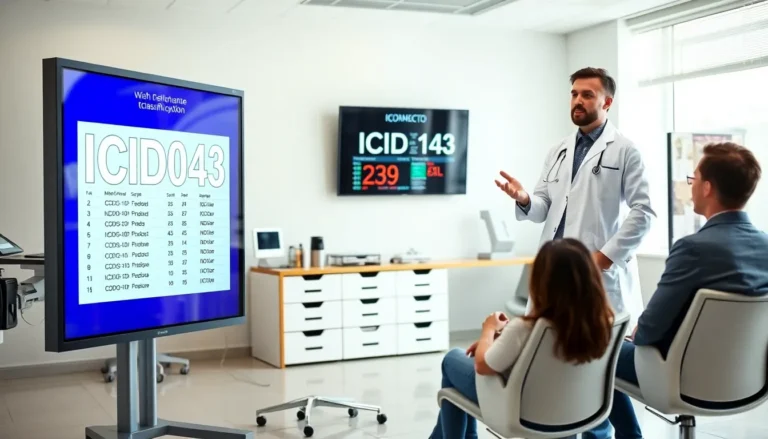Table of Contents
ToggleWhen it comes to education, curriculum development is the unsung hero behind the scenes. Think of it as the secret sauce that transforms bland lessons into a feast of knowledge. Without a well-crafted curriculum, students might as well be trying to navigate a maze blindfolded—confusing and frustrating!
Understanding Curriculum Development
Curriculum development is fundamental in shaping educational experiences. It involves systematically designing and evaluating learning programs to ensure they meet students’ needs.
Definition and Importance
Curriculum development refers to the process of planning, implementing, and assessing educational courses or programs. This approach is crucial for several reasons. Effective curriculum enhances learning outcomes by providing clear objectives and structured content. It also fosters engagement by connecting academic subjects to real-world applications. A well-developed curriculum addresses diverse learner needs, promoting inclusivity. Educational stakeholders, like teachers and administrators, benefit from a cohesive framework that guides instruction. Furthermore, successful curriculum design can lead to improved student performance and satisfaction.
Key Principles of Curriculum Development
Several key principles underpin effective curriculum development. First, alignment with educational standards ensures that programs meet specific learning goals. Second, stakeholder involvement is vital; educators, parents, and students should provide input during the development process. Third, flexibility must be built into the curriculum to accommodate various learning styles and paces. Fourth, assessment strategies should be integrated to measure learner progress effectively. Fifth, continuous evaluation helps refine the curriculum based on feedback and emerging educational trends. Following these principles leads to a more effective and responsive educational framework.
The Process of Curriculum Development

Curriculum development involves a systematic approach to enhancing educational programs. It requires careful planning, implementation, and assessment to address student needs effectively.
Needs Assessment
Needs assessment serves as a foundational step. It identifies gaps in current curricula and recognizes students’ knowledge, skills, and interests. Gathering data through surveys, interviews, and focus groups helps stakeholders understand requirements more comprehensively. Engaging educators, parents, and students ensures a well-rounded perspective. Clarifying objectives also guides the curriculum’s direction.
Designing the Curriculum
Designing the curriculum builds on information gathered during the needs assessment. Objectives must align with educational standards and reflect stakeholder input. Integrating diverse learning styles ensures that materials are accessible to all students. Developing lesson plans, instructional materials, and assessments takes careful consideration of current research and best practices. This stage emphasizes coherence and relevance across various subjects and grade levels.
Implementation Strategies
Successful implementation strategies connect the curriculum to classroom practices. Training teachers ensures they understand the curriculum’s goals and methods. Establishing timelines, resources, and support mechanisms supports educators during the transition. Communication with all stakeholders promotes a shared vision and commitment. Monitoring the implementation process helps identify challenges and successes, ensuring continuous improvement.
Evaluation and Revision
Evaluation and revision complete the curriculum development cycle. Regular assessments of student performance and feedback from educators indicate areas for improvement. Analysis of data informs revisions and enhances curricular effectiveness. Engaging stakeholders in the evaluation process fosters collaboration and shared ownership. Continuous reflection ensures the curriculum remains relevant to evolving educational needs.
Trends in Curriculum Development
Curriculum development trends reflect the evolving demands in education. These trends encompass technology integration and inclusive education practices.
Technology Integration
Technology integration transforms learning experiences. Educators utilize digital tools to enhance engagement. For instance, interactive software offers students unique ways to grasp concepts. Mobile devices promote personalized learning, allowing students to progress at their own pace. Teachers also benefit from professional development focused on tech strategies, ensuring effective implementation. Data indicates that interactive technology can increase student motivation by up to 30%. Utilizing learning management systems streamlines communication between teachers and students, fostering collaboration.
Inclusive Education Practices
Inclusive education practices prioritize diverse learning needs. Educators adapt curricula to accommodate various abilities and backgrounds. For example, differentiated instruction tailors lessons to support all learners effectively. Collaborative teaching models, where general and special education teachers work together, enhance student experiences. Furthermore, incorporating universal design principles ensures accessibility for all students. Research shows that inclusive classrooms can improve social skills and academic performance. Involving families in curriculum development enhances support systems, leading to better student outcomes.
Challenges in Curriculum Development
Curriculum development faces several challenges that can hinder its effectiveness.
Resource Limitations
Limited resources complicate curriculum development. Schools often operate on tight budgets, affecting the availability of technology, materials, and professional development opportunities. Educators may struggle to access updated instructional tools and relevant training due to budget constraints. Consequently, this scarcity can affect the quality of curriculum implementation. Additionally, inadequate funding may lead to insufficient staffing, making it difficult to support diverse student needs. Alternative solutions include seeking grants and collaborations that can enhance available resources, thereby ensuring educators receive necessary support.
Stakeholder Engagement
Engaging stakeholders poses another challenge in the curriculum development process. While their involvement is crucial, educators often find difficulties in maintaining effective communication with parents, community members, and students. Differences in expectations and priorities can arise, complicating the alignment of curriculum goals. Regular meetings and feedback sessions foster open dialogue and ensure all voices are heard, which strengthens the curriculum’s quality. Prioritizing collaborative efforts among stakeholders results in a more comprehensive understanding of students’ needs and ultimately enhances the curriculum’s relevance.
Curriculum development stands as a vital component in shaping effective educational experiences. By prioritizing alignment with standards and engaging stakeholders, educators can create a framework that meets diverse student needs. The integration of technology and inclusive practices further enhances learning, making it more engaging and relevant.
Ongoing evaluation and adaptation ensure that curricula remain responsive to the ever-changing educational landscape. Addressing challenges like resource limitations and stakeholder engagement is essential for success. Ultimately, a well-developed curriculum not only fosters academic growth but also prepares students for real-world challenges, paving the way for a brighter future.







